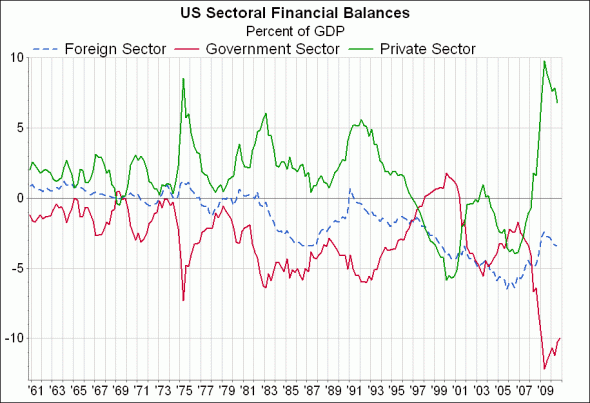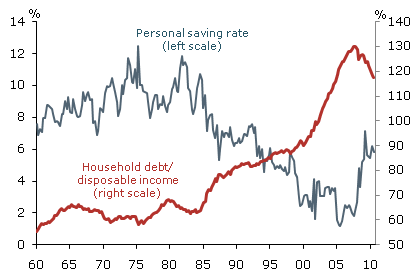In a recent post, “Should the US balance its budget“, I argued that it would be a folly for the US to try to balance its budget in the near term, as this would seriously impede the economy’s recovery from the recent deep recession.
But this leaves us with some obvious questions. Is the economy going to be forever dependent on huge amounts of government spending to remain afloat? What is the way out of this mess? And what needs to happen for the US economic recovery to be sustainable?
In order to arrive at an answer to this question we are going to have to get into a few equations, but hopefully it will make the explanation easier to understand. To review, here is the sectoral balances identity that we examined in my last post.
Private Sector Balance + Government Sector Balance – Current Account Balance = 0
As you may recall, this suggests that if the private sector desires to spend less than its income in aggregate, and the country is running a trade deficit, a government deficit is inevitable.
The chart below (from Pragmatic Capitalism) shows that the massive increase in the government deficit in 2008 mirrored a huge increase in the financial balance of the private sector.

This is an interesting observation, but it obscures a lot of what was really going on. If we divide the private sector into households, and the business (or corporate) sectors, we can rewrite the equation as follows.
Household Sector Balance + Business Sector Balance + Government Sector Balance – Current Account Balance = 0
Now, one of the characteristics of the recent crisis is that (unlike Japan’s bubble economy of the 1980s, for example), it was driven not so much by corporate excesses (apart from the banks), but more by excessive borrowing in the household sector. Let’s rearrange the equation above to isolate how the household sector’s financial balance is determined.
Household Sector Balance = Current Account Balance – Business Sector Balance – Government Sector Balance
The chart below from the San Fransisco Fed (h/t again to Pragmatic Capitalism) suggests that while households have increased their savings rates and starting paying off or defaulting on their debt, this deleveraging process could still have a long way to go.

In other words, the household sector’s financial balance is likely to be positive for quite a long time. This has some pretty big implications for other sectors in the economy. As the San Fransisco Fed says:
Going forward, households may keep trying to reduce excessive debt loads by increasing their saving… higher saving rates imply correspondingly lower rates of domestic household consumption growth so that a larger share of GDP growth would need to come from business investment, net exports, or government spending.
The part in bold follows directly from the sectoral balances equation above.
Now, as I said in my last post, it is clear that we are running into some severe political constraints on the ability of deficit spending to take up the slack.
Growing Exports
I think it would be disastrous if the US tried to balance its budget in the near term. But given the political constraints just mentioned, it seems that as soon as possible it would be desirable for the US to implement policies that promote business investment and exports.
Wynne Godley, the grandfather of the sectoral balances approach, actually came to similar conclusions in a series of very prescient papers written in the 1990s and early 2000s. Godley argued that the rapid rise in US private sector debt was unsustainable, and that if the US did not change course, its economy was headed for a disaster — from which the only way out would be a massive increase in government spending to levels that were not politically sustainable.
Here is what he said in 1999:
Given unchanged fiscal policy and accepting the consensus forecast for growth in the rest of the world, continued expansion of the U.S. economy requires that private expenditure continues to rise relative to income. Yet while anything can happen over the next year or so, it seems impossible that this source of growth can be forthcoming on a strategic time horizon. The growth in net lending to the private sector and the growth in the growth rate of the real money supply cannot continue for an extended period.
Moreover, if …the growth in net lending and the growth in money supply growth were to continue for another eight years, the implied indebtedness of the private sector would then be so extremely large that a sensational day of reckoning could then be at hand.
As we all know, that “sensational day of reckoning” came in 2008. In any case, Godley came to the conclusion that there was only one sustainable long-term solution to the “strategic predicament” of the US.
There would appear to be only one antidote to this predicament, that net export demand provides the motor for sustained growth in the future; U.S. exports must rise faster than imports by very large amounts and for a long period of time.
As you can see from the graph above, the US has run a current account deficit almost continually since the late 1970s. And now that deficit is widening again thanks to the rise in oil prices. Turning this deficit around is not going to be easy. It is probably going to take some combination of a weaker US dollar and faster growth in consumer demand in the rest of the world. The central bankers know this, which is why the Bernank has been prattling on about global rebalancing for some time now. Hardly anybody is listening.
But at the end of the day, as long as China (and many other emerging market economies) continues to peg its currency to the dollar and accumulate massive amounts of dollars, it is going to be difficult for the US to reduce its deficit. China is making the right noises about trying to switch to a more consumption-based society, which could help boost US exports. But this will take time. And what will the USA sell? Much of the manufacturing sector has shifted offshore, with a permanent loss of expertise in many industries.
Stimulating Business Investment
So what about business investment? While corporate profits have rebounded very strongly in the US since the crisis ended, for the most part, companies are not reinvesting these profits.
In a recent post at Naked Capitalism, Rob Parenteau offers an interesting take:
There is a glut of profits, and these profits are not being reinvested in tangible plant and equipment. Companies, ostensibly under the guise of maximizing shareholder value, would much rather pay their inside looters in management handsome bonuses, or pay out special dividends to their shareholders, or play casino games with all sorts of financial engineering thrown into obfuscate the nature of their financial speculation, than fulfill the traditional roles of capitalist, which is to use profits as both a signal to invest in expanding the productive capital stock, as well as a source of financing the widening and upgrading of productive plant and equipment.
What we have here, in other words, is a failure of capitalists to act as capitalists… So rather than marching to Austeria, we need to kill two birds with one stone, and set fiscal policy more explicitly to the task of incentivizing the reinvestment of profits in tangible capital equipment. A program to do so would include the following measures:
1) a prohibitive tax on retained earnings that are not reinvested with a 24 month period after they have been booked;
2) a financial asset turnover tax that raises the cost to businesses of playing casino games in various financial asset markets, rather than reinvesting profits in the productive capital stock;
3) a reinvigorated public or public/private investment program that helps speed up the shift to, and lower the costs of production of new energy technologies.
Interesting ideas. Are any of them likely to happen? Probably not. What about the export solution that we examined above? Problematic. Meanwhile, austerity mania is in the air as we head towards another Presidential election in 2012.
What does all this mean? My best guess is that we are heading for another crash sometime in the coming few years. What do you think?